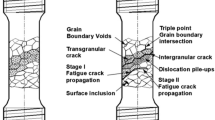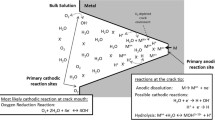Abstract
We analyze the processes of initiation and growth of corrosion fatigue cracks on the surface of a semicircular notch depending on the stress field and local electrochemical processes running inside the notch. For this purpose, we consider a typical corrosion-active system formed by low-strength carbon steel placed in a 3% NaCl solution. In this system, the electrochemical dissolution of the metal is predominant. A semicircular notch is regarded both as a stress concentrator and as a local corrosion electrolyzer. The field of elastoplastic stresses near the notch is computed by the finite-element method with the help of the CASTEM-2000 software package. The early stages of corrosion fatigue are investigated and the existence of a critical density of cracks q * on the surface of the notch is demonstrated (above this density, the cracks undergo intense coalescence leading to the formation of the macrocrack). We propose a model of this process and an analytic relation for the prediction of the number of cycles N * corresponding to the critical density q *. This relation takes into account the constants of electrochemical dissolution of the metal, the density of corrosion current i cor, and the effective stress σeff, which can be regarded as the mean level of stresses in a segment 0 ≤ x ≤ x eff from the notch tip.
Similar content being viewed by others
References
V. V. Panasyuk (editor), Fracture Mechanics and Strength of Materials: A Handbook [in Russian], Naukova Dumka, Kiev (1988–1990).
G. Pluvinage, “Fracture mechanics from notches,” Fiz. Khim. Mekh. Mater., 34, No. 6, 7–20 (1998).
G. Pluvinage, “Application of notch fracture mechanics to fracture emanating from stress concentrators,” in: Advances in Computational Engineering Sciences 97, San Jose (1997), pp. 213–218.
I. M. Dmytrakh and V. V. Panasyuk, Influence of Corrosive Media on the Local Fracture of Metals near Stress Concentrators [in Ukrainian], Karpenko Physicomechanical Institute, Ukrainian Academy of Sciences, Lviv (1999).
G. Qilafku, Z. Azari, M. Gjonaj, and G. Pluvinage, “On the fatigue failure and fatigue life prediction for notched specimens,” Fiz. Khim. Mekh. Mater., 34, No. 5, 17–27 (1998).
G. Pluvinage, “Notch effects in high cycle fatigue,” in: Proceedings of the Internat. Congress on Fracture (ICF9), Vol. 3, Sydney, (1997), pp. 1239–1250.
G. Pluvinage, “Fatigue and fracture emanating from a notch; the use of the notch stress intensity factor,” Nucl. Eng. Design, 185, 173–184 (1998).
S. Bentachfine, G. Pluvinage, J. Gilgert, Z. Azari, and D. Bouami, “Notch effect in low cycle fatigue,” Int. J. of Fatigue, 21, No. 2, 421–430 (1999).
N. Kadi, M. Gjonaj, and G. Pluvinage, “Volumic approach of fatigue failure of notched specimens,” in: Proceedings of the Third Workshop on the Influence of Local Stress and Strain Concentrators on Reliability and Safety of Structures, COPERNICUS CIPACT94 0194, Univ. of Miskolc, Miskolc, Hungary (1998), pp. 9–18.
G. Qilafku, Z. Azari, N. Kadi, N. Gjonaj, and G. Pluvinage, “Application of a new model proposal for the fatigue life prediction on notches and keyseats,” Int. J. of Fatigue, 21, No. 8, 753–760 (1999).
V. V. Panasyuk and I. M. Dmytrakh, “Determination and prediction of corrosion fatigue cracks nucleation from the surface of semicircular notches,” in: Proc. of the 12th European Conf. on Fracture (ECF 12), EMAS (1998), pp. 1187–1192.
I. M. Dmytrakh, V. V. Panasyuk, and O. A. Ezers'ka, “Mechanisms of electrochemical dissolution of a loaded metal in the process of its local interaction with corrosive media,” Fiz. Khim. Mekh. Mater., 34, No. 2, 18–28 (1998).
V. V. Panasyuk and I. M. Dmytrakh, “Methods for stress corrosion crack growth studies and electrochemical measurements within cracks,” in: Proc. of the 18th Symp. on the Experimental Mechanics of Solids (October 1998), Warsaw Univ. of Tech., Jachranka Warsaw (Poland) (1998), pp. 350–355.
R. Akid and K. J. Miller, “The effect of solution pH on initiation and growth of short fatigue cracks,” in: Proc. of the 8th European Conf. on Fracture (ECF 8), EMAS, Torino (1990), pp. 1403–1411.
R. Akid and I. Dmytrakh, “Influence of surface deformation and electrochemical variables on corrosion and corrosion fatigue crack development,” Fatigue Fract. Eng. Mater. Struct., 21, No. 7, 903–911 (1998).
I. M. Dmytrakh, R. Akid, and K. J. Miller, “Electrochemistry of deformed smooth surfaces and short corrosion fatigue crack growth behaviour,” Brit. Corros. J., 32, No. 2, 138–144 (1997).
R. E. Peterson, Stress Concentration Factor, Wiley, New York (1974).
Author information
Authors and Affiliations
Rights and permissions
About this article
Cite this article
Dmytrakh, I.M., Pluvinage, G. & Qilafku, G. On Corrosion Fatigue Emanating from Notches: Stress Field and Electrochemistry. Materials Science 37, 184–198 (2001). https://doi.org/10.1023/A:1013202607619
Issue Date:
DOI: https://doi.org/10.1023/A:1013202607619




